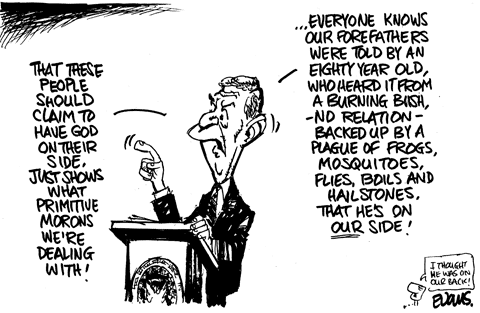
Top Religion Headlines of 2006 (Source: BeliefNet.com)
From Baghdad to the ballot box, 2006 was a year of upheaval. A prominent pastor and a powerful conservative Christian senator both exited public life (at least for now). The quiet, unassuming Amish world was thrust into the national spotlight. A movie and a cartoon each sparked controversy, and in the case of the latter, violence. Meanwhile, "old" issues--stem cell research, gay marriage--continued to divide. Read through the top faith-related news stories of 2006, as voted on by the Religion Newswriters Association:
1. Protests Erupt Over Muhammad Cartoon - Muslims in many countries reacted sharply--and often violently--to the publication in a Danish newspaper of a series of political cartoons depicting Muhammad. Muslims consider any portrayal of the prophet inappropriate, but were particularly inflamed by a cartoon of Muhammad with a bomb as his turban. As the violence spread to such places as Somalia, Thailand, and the Palestinian territories, many publications in Europe and elsewhere reprinted the cartoon in solidarity with the Danish newspaper, further fueling Muslims' anger.
2. Pope Benedict Angers Muslims - Pope Benedict XVI angered Muslims by quoting in a speech from a 14th-century Christian emporer who said that Muhammad was "evil and inhuman." The pope apologized and largely diffused the situation with a trip to Turkey, during which he prayed at a mosque and voiced support for Turkey's bid to become the first majority-Muslim member of the European Union.
3. The Episcopal Church Is Threatened by Schism - The Episcopal Church riled conservatives by electing a presiding bishop who supported the consecration of a gay bishop. Seven Episcopal dioceses refused to recognize the leadership of Presiding Bishop Katharine Jefferts Schori, the first woman elected to the top post. Some congregations have left the U.S. church and put themselves under the authority of African or South American bishops.
4. Ted Haggard Admits to 'Sexual Immorality' - The charismatic and powerful evangelical leader Ted Haggard was dismissed as pastor of the influential New Life Church in Colorado Springs and resigned as president of the National Association of Evangelicals after allegations surfaced of gay sex and methamphetamine use. Haggard has admitted that at least some of the accusations are true, calling himself "a deceiver and a liar," and saying in a letter to his congregation, "There is a part of my life that is so repulsive and dark that I've been warring against it all of my adult life."5. Electoral Setbacks for Christian Conservatives - Candidates backed by Christian conservatives, including Rick Santorum (at right)--the powerful Pennsylvania senator who was one of the most steadfast supporters of the conservative agenda--suffered a series of defeats in the fall elections. An increasing number of Christian conservatives are calling for evangelicals to broaden their focus to include a wider array of issues and voices, or to take a step back from intense political involvement altogether.
6. Religious Violence Grows in the Mideast - As religious voices increasingly called for peace in Iraq, conflicts between Iraq's Sunni and Shiite Muslims intensified, and observers fear other nations could be drawn into the conflict. In Lebanon, the Israeli incursion, aimed at curbing attacks by Hezbollah, touched off major strife that is threatening the stability of Lebanon's government, while Iran's president Mahmoud Ahmadinejad repeatedly called for Israel's destruction and continued defying the West by refusing to abandon his nuclear ambitions.
7. The Amish Forgive a Schoolhouse Killer - Pennsylvania's Amish community was thrust into the national spotlight when a gunman entered a one-room schoolhouse in Nickel Mines, Pa., and shot 10 Amish girls, killing five, before shooting himself. Despite their shock and grief, the community reacted by publicly forgiving the gunman, bringing food to his family, and attending his funeral. Children who survived the massacre told of one of the murdered girls, Marian Fisher, who reportedly offered to be the first killed, to spare the others.
8 (tie). 'The Da Vinci Code' Movie Opens - Dan Brown's novel has sparked controversy since its publication, with its claims that Mary Magdalene and Jesus were married and had children--and its allegations that the Vatican has covered up these "facts," often violently, throughout the centuries. In the months leading up to the May release of "The Da Vinci Code" movie, Christians were divided over whether to boycott the film or engage with it as an opportunity for evangelism. Most seemed to take the latter route.
8 (tie). Gay Marriage Continues to Divide - In New Jersey, the state Supreme Court ruled that same-sex couples are entitled to the same benefits as married couples, leaving the legislature to decide what to call the arrangement. In response, the legislature passed and the governor signed a bill legalizing "civil unions" in the state. In the November elections, voters made Arizona the first state to defeat a proposed same-sex marriage ban. At the same time, referendums in seven other states passed, officially outlawing gay marriage there.
10. Pres. Bush Vetoes Stem-Cell Research Expansion - In the first veto of his presidency, Bush said no to a bill that would have expanded stem-cell research. The decision was no surprise: Bush has been consistently opposed to scientific research that involves destroying viable human embryos. The issue also was prominent in the Missouri Senate race, during which Michael J. Fox campaigned in support of a referendum to expand stem cell rearch and for Democrat Claire McCaskill, who backed the proposed bill. Other celebrities joined in on either side of the issue, making commercials that aired leading up to the election, in which McCaskill won and the referendum passed.





